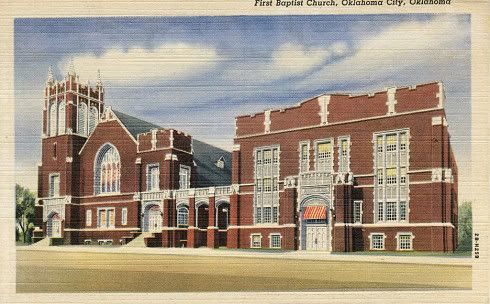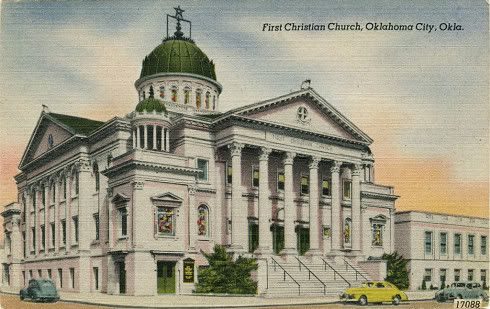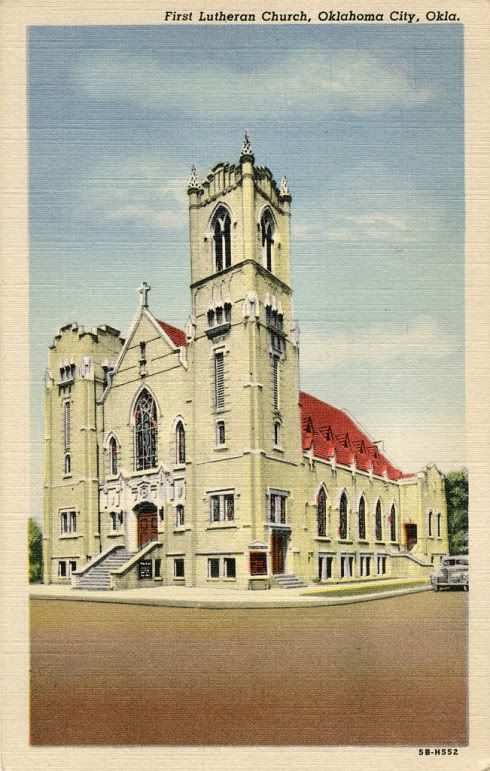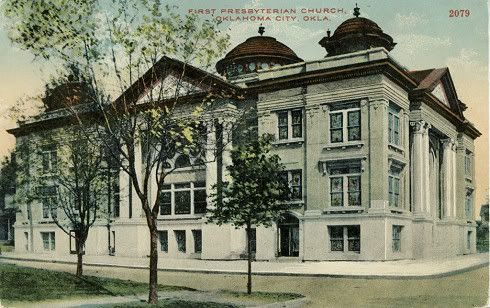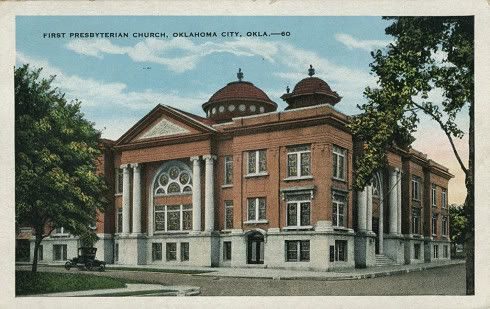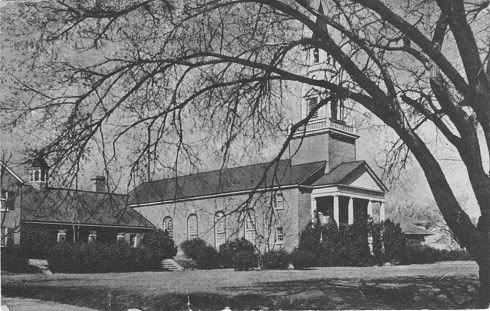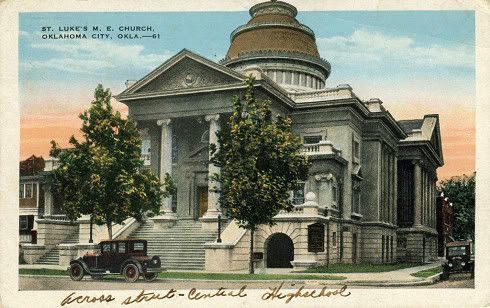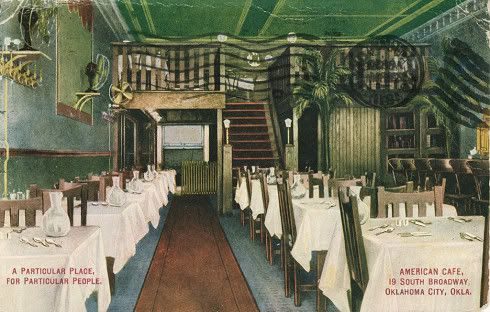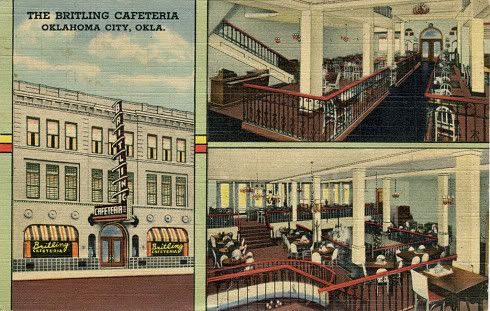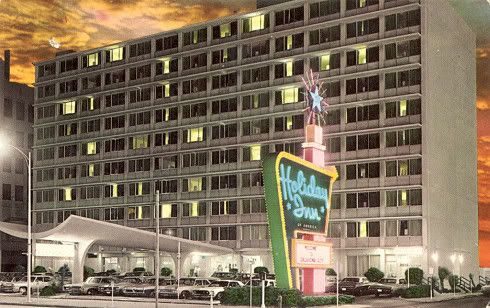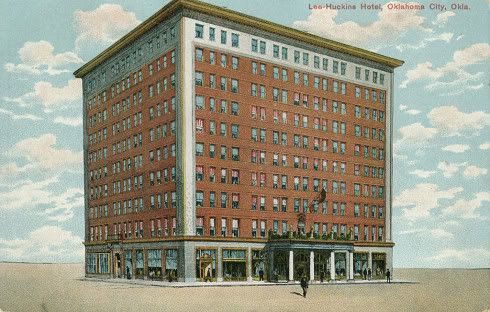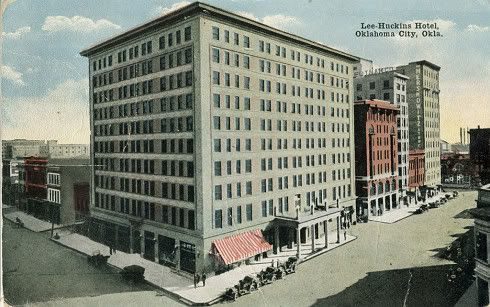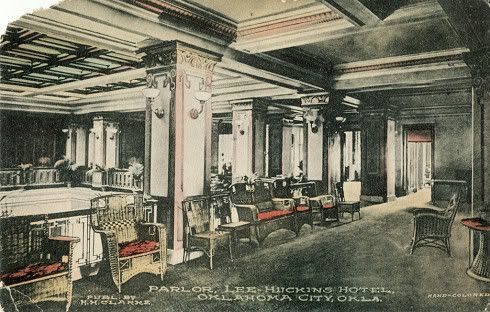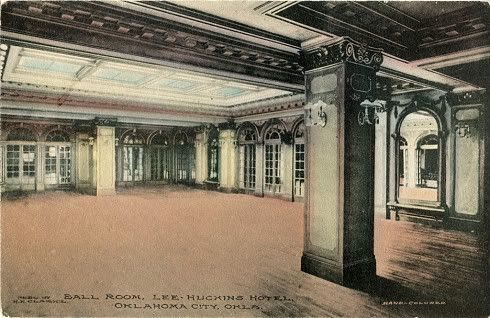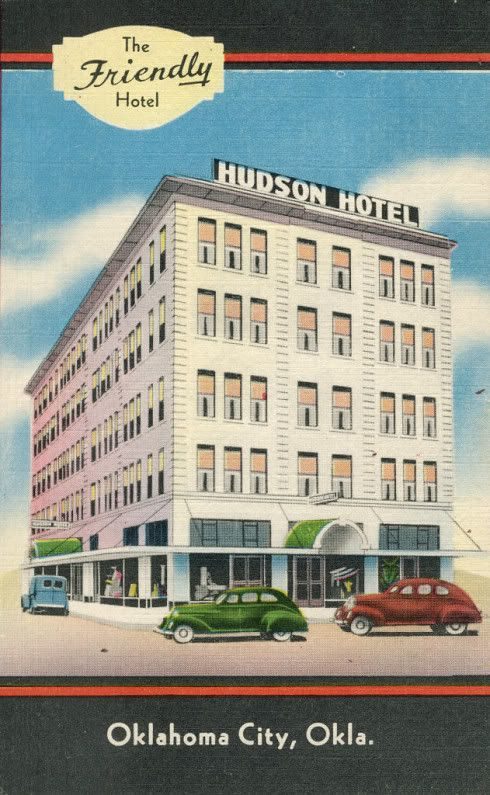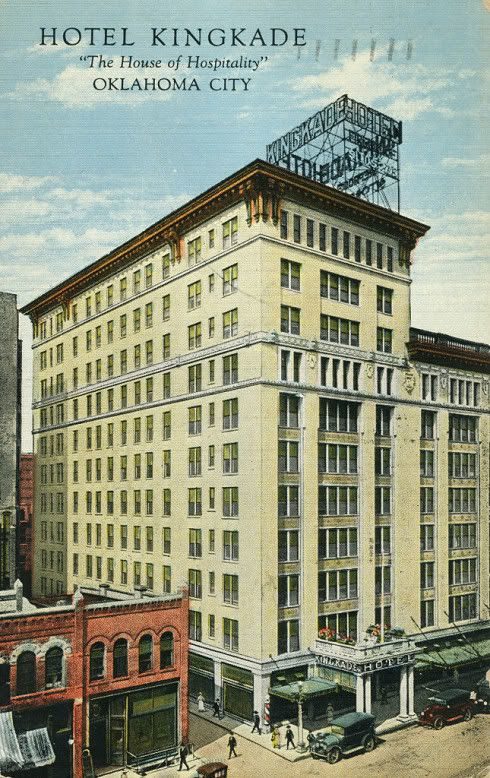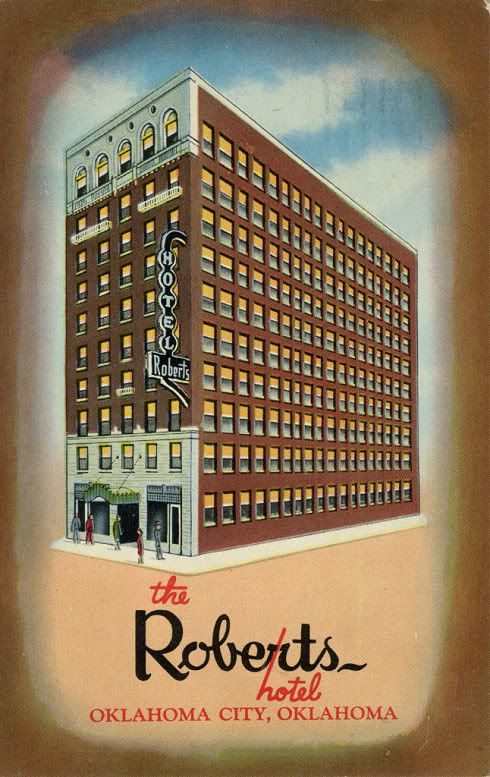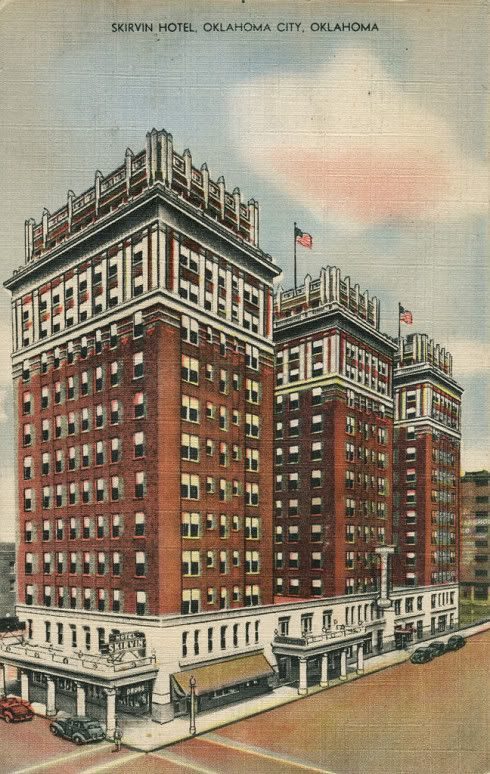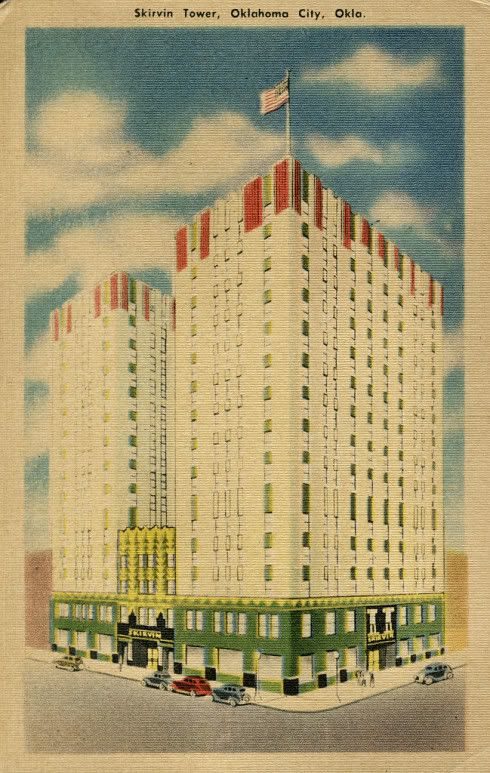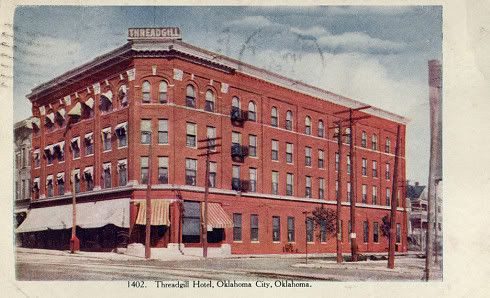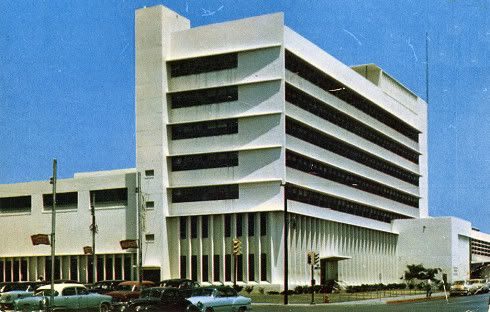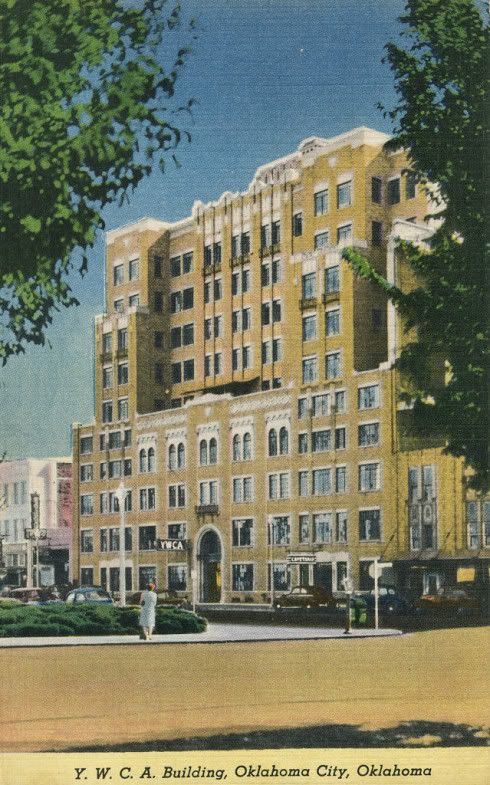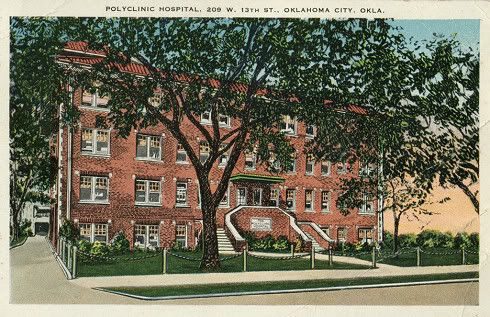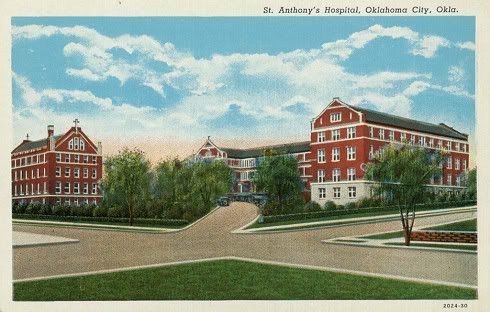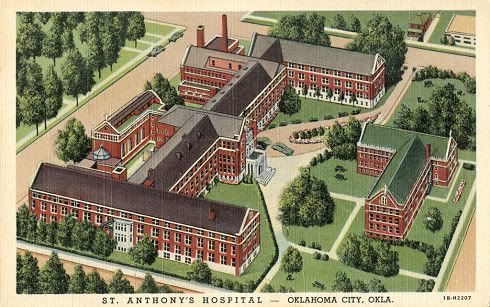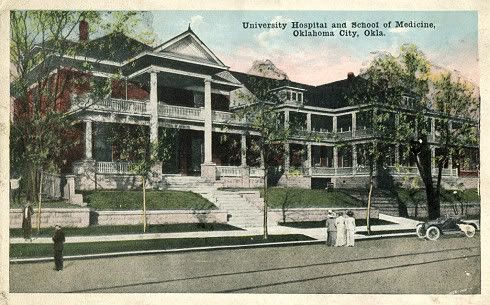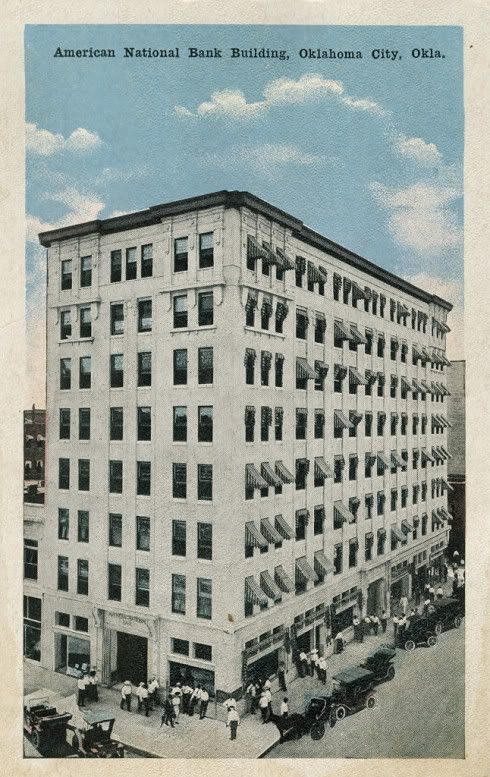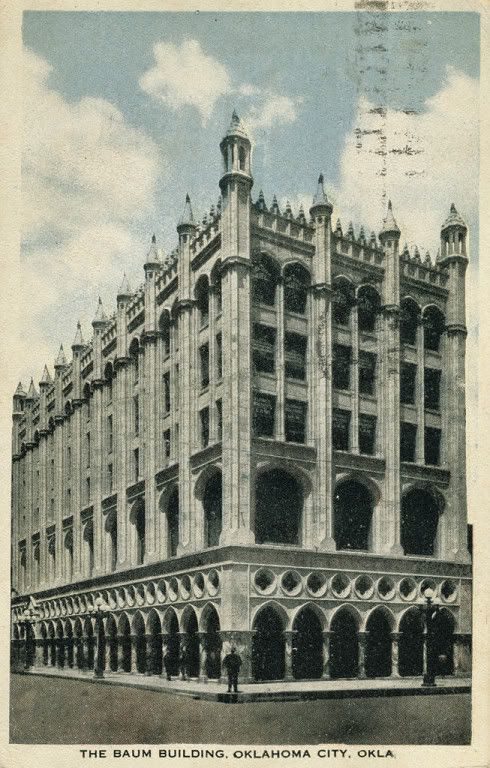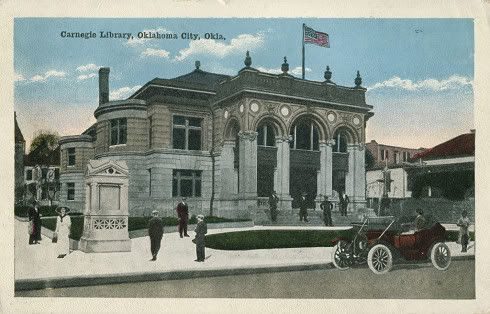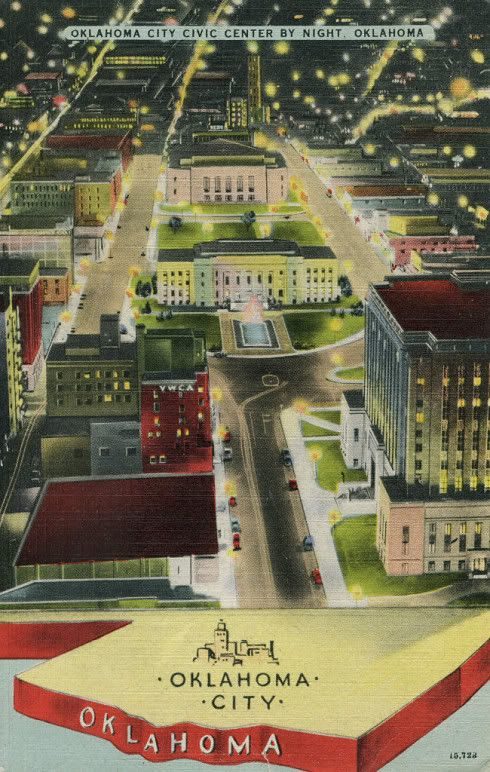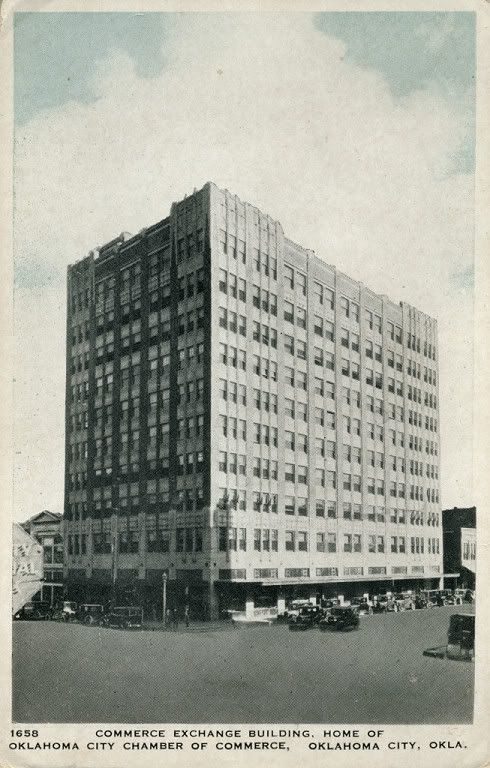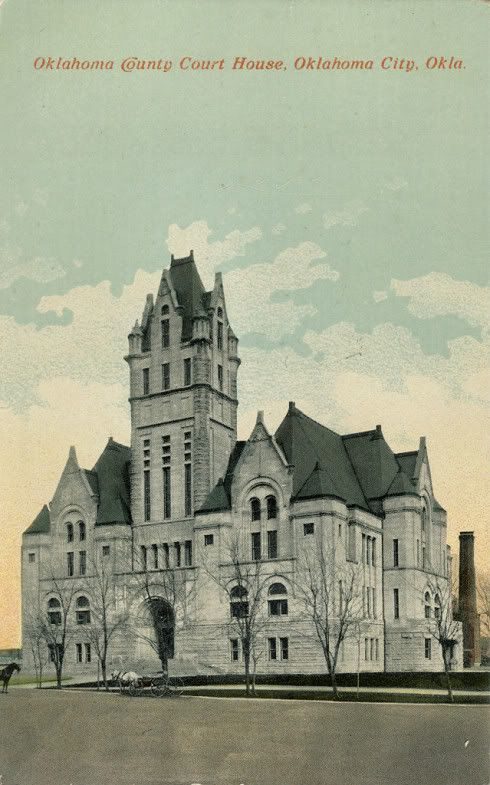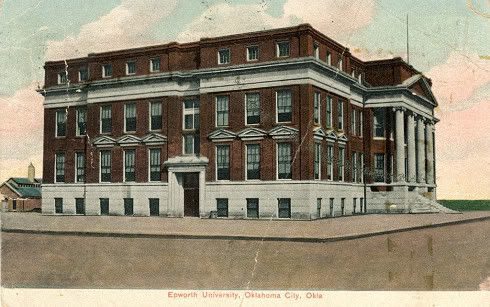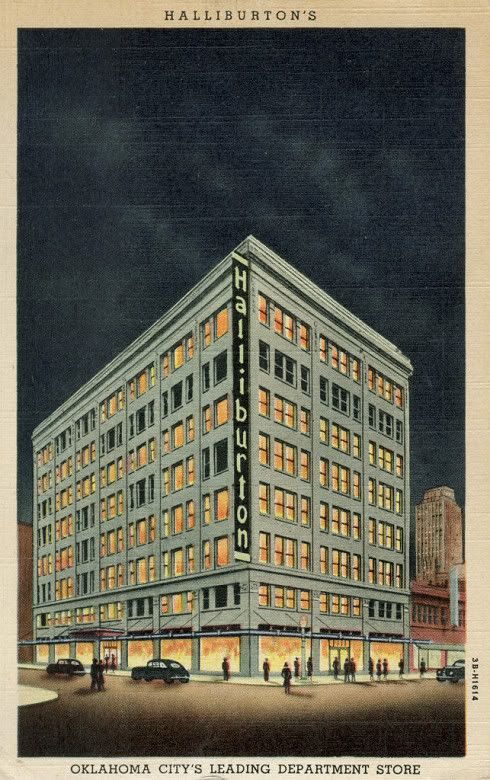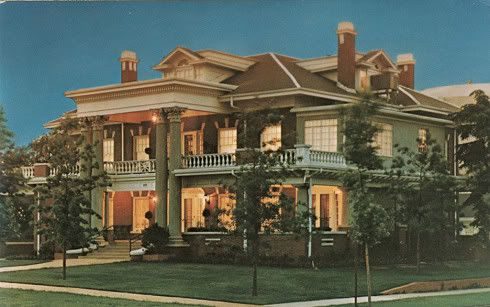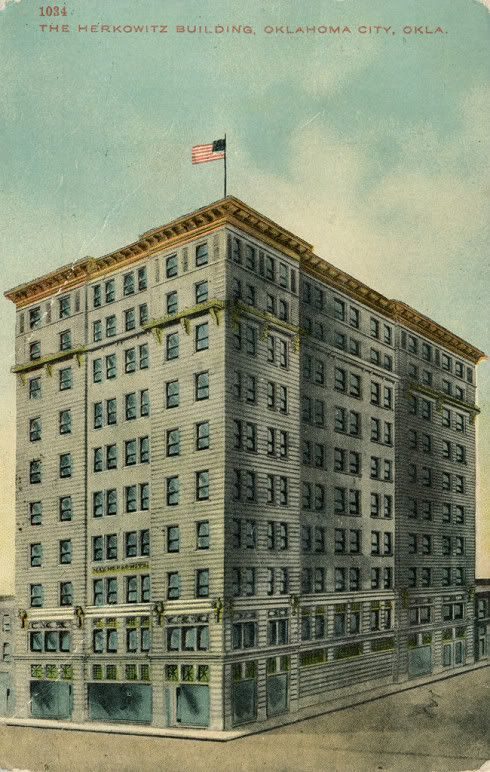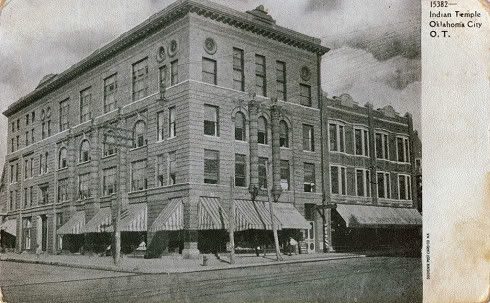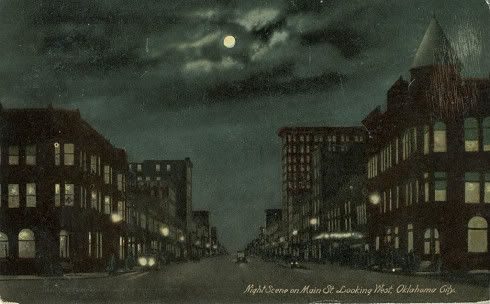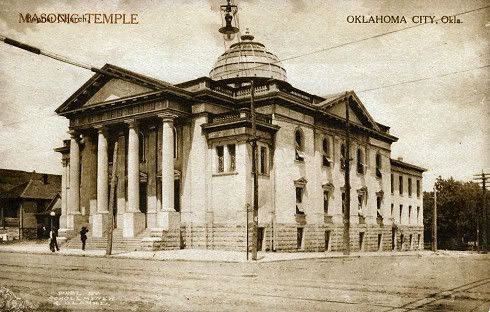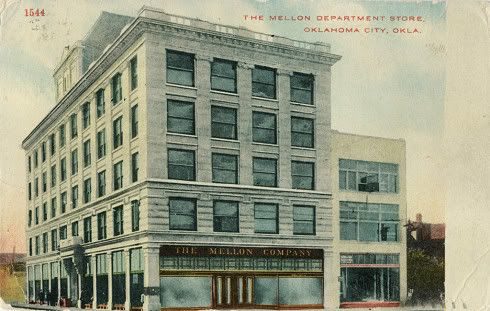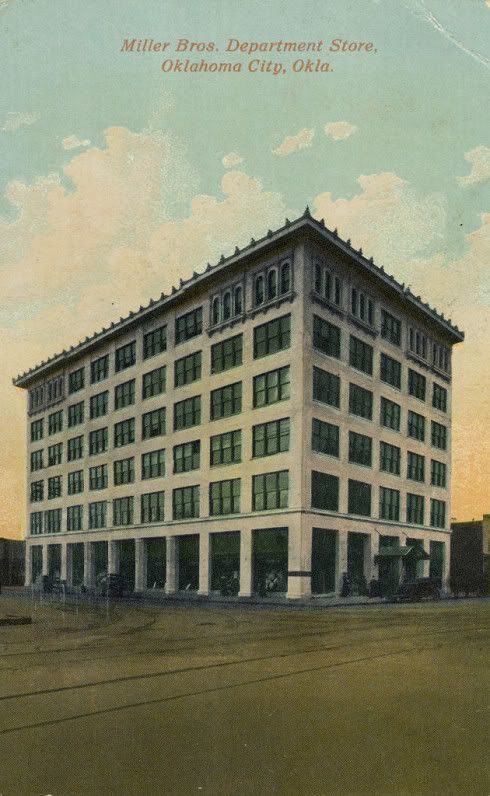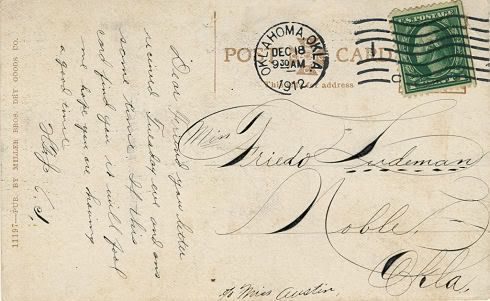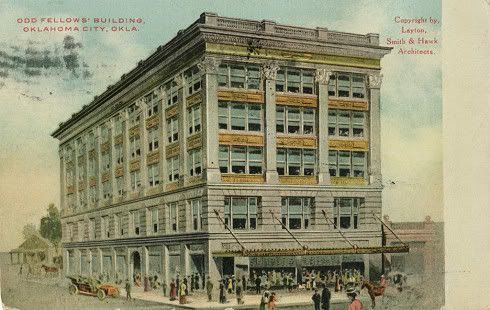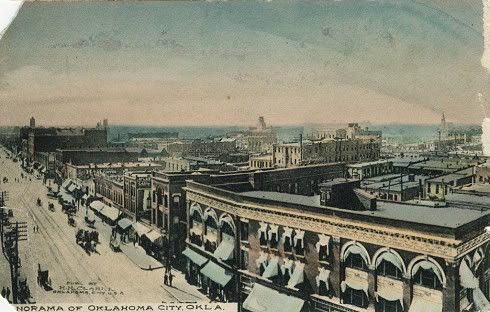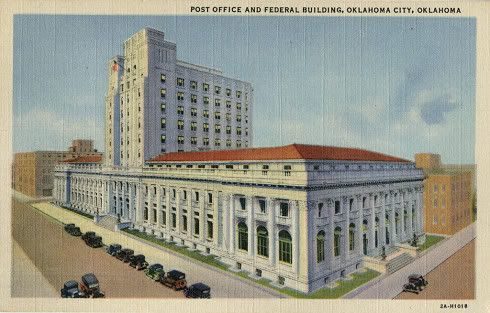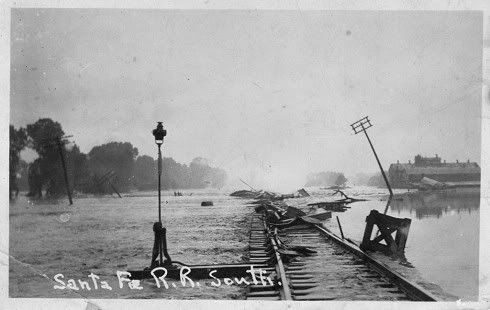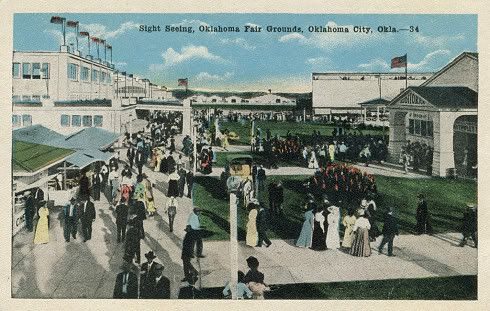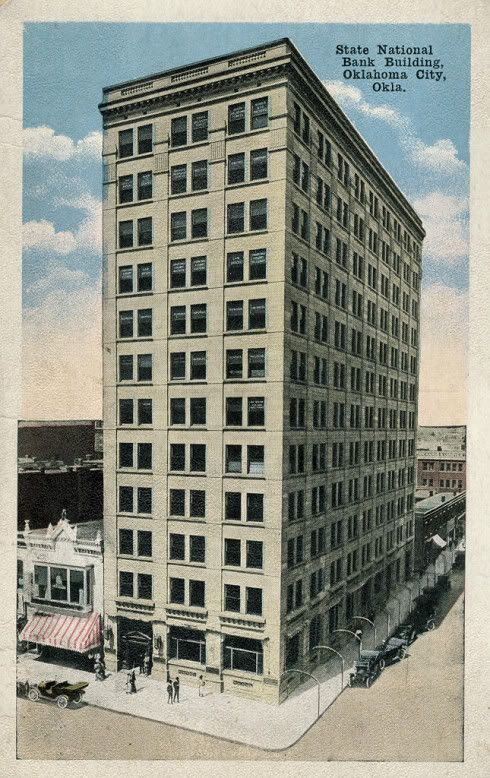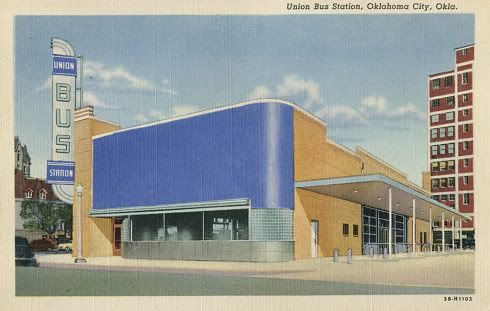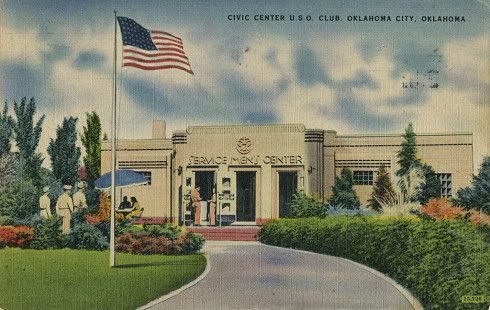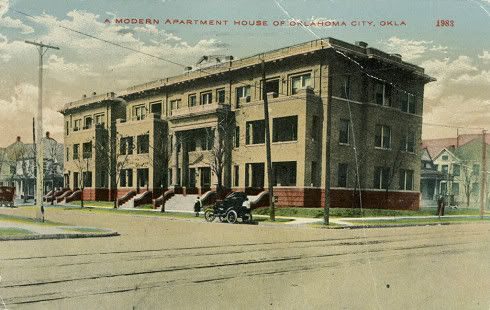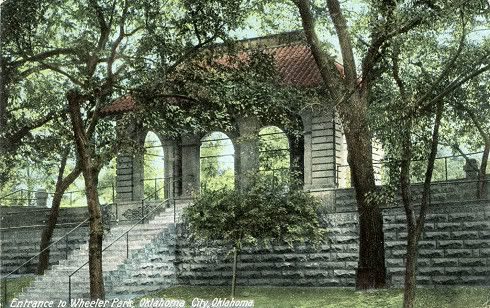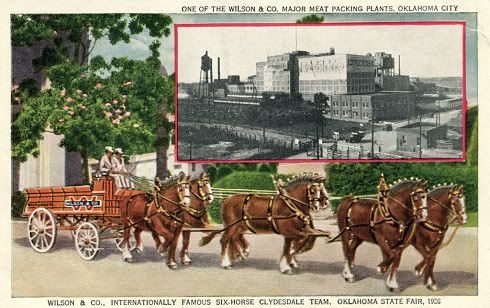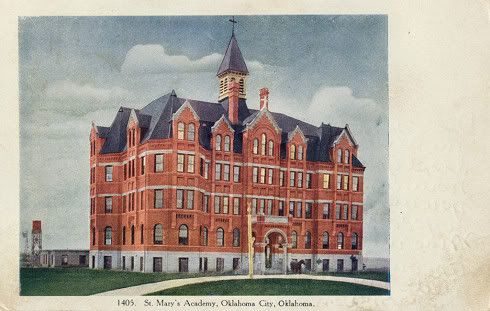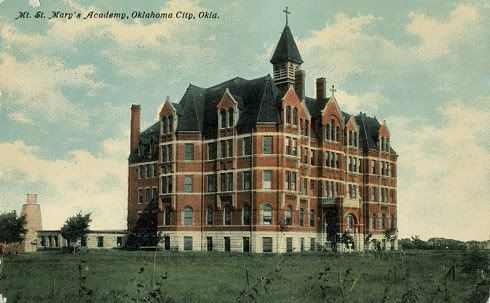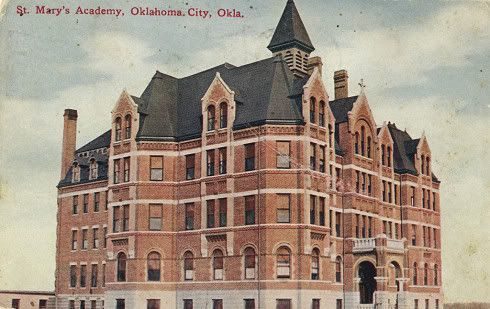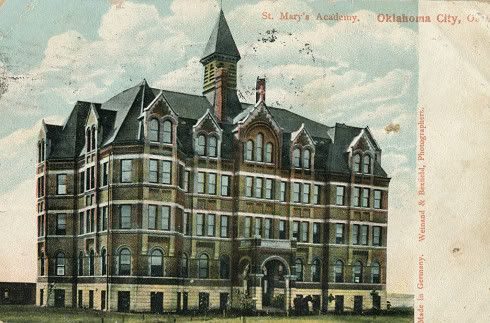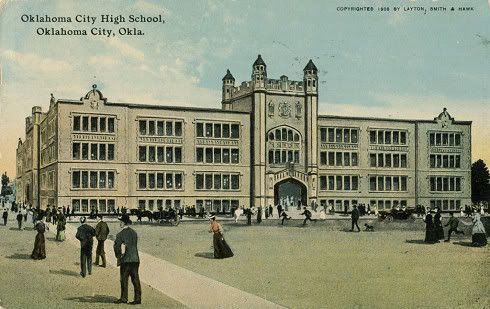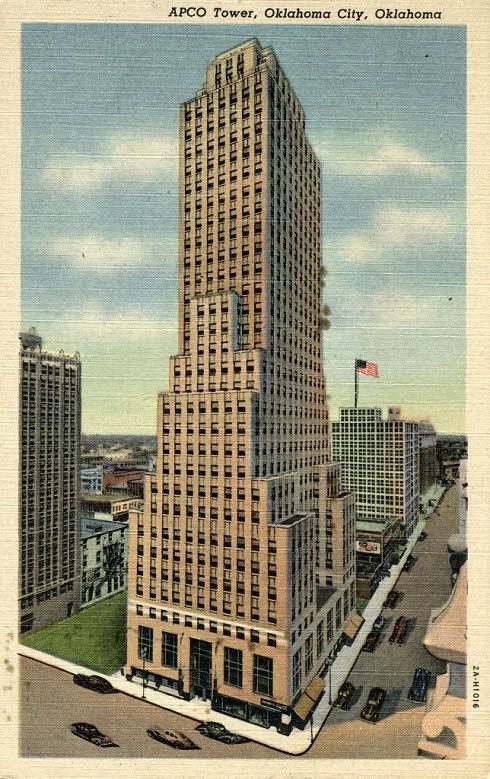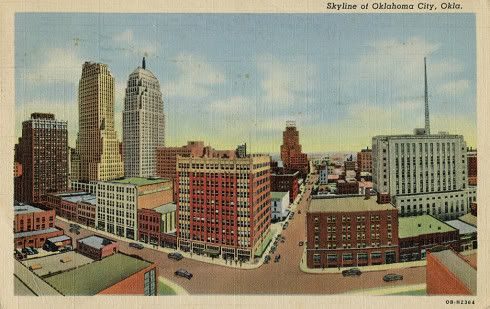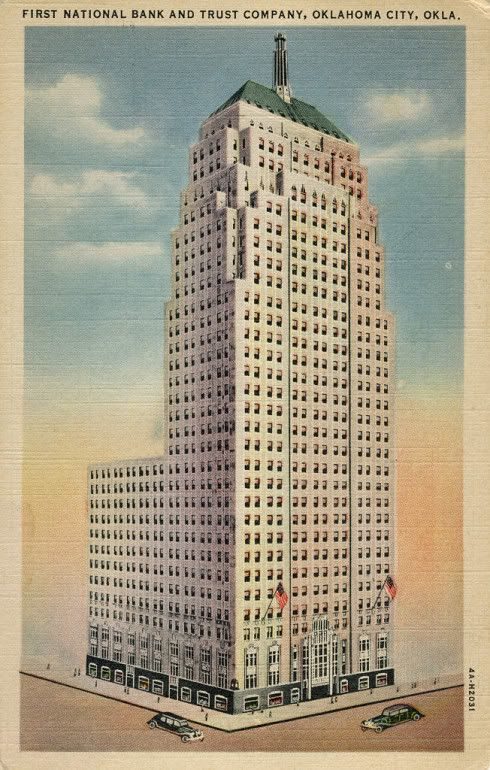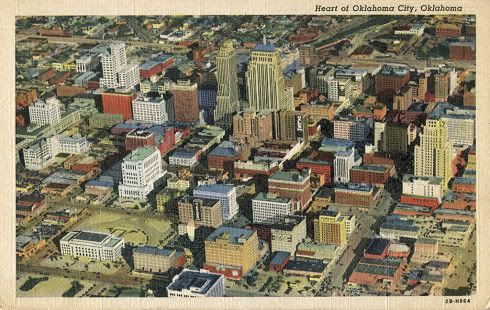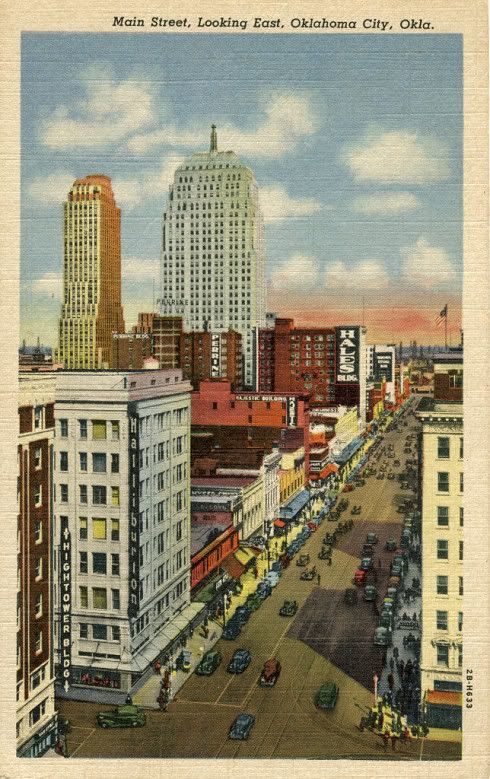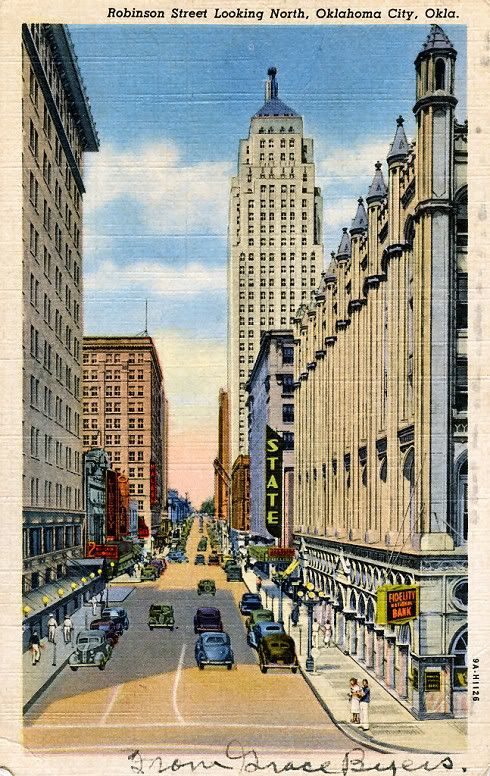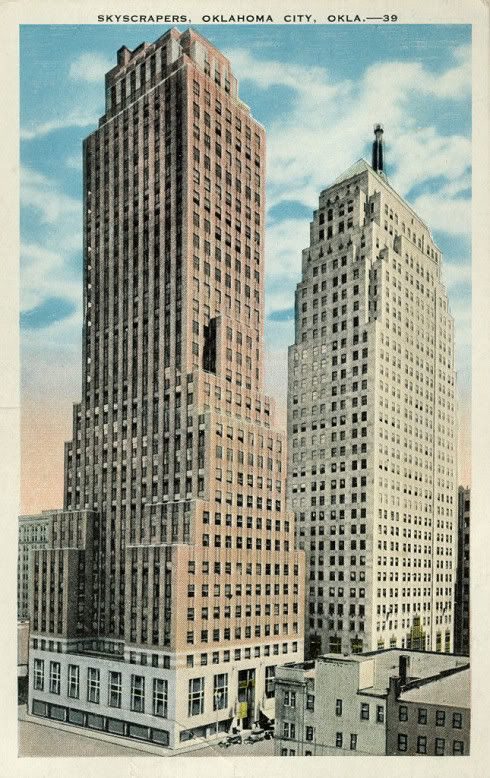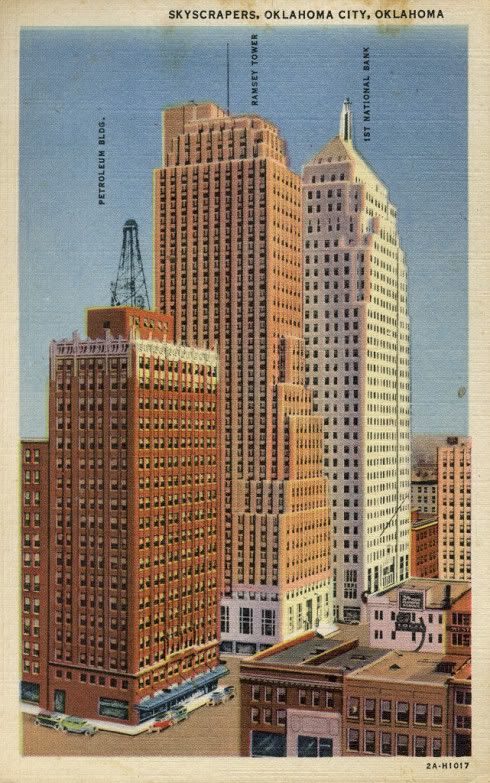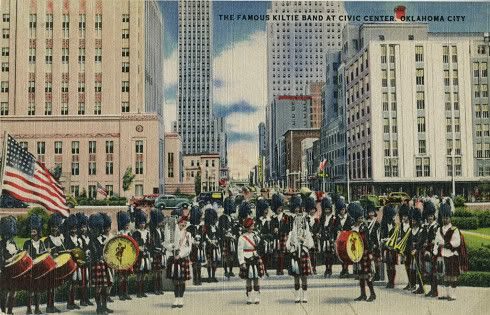
Perusing vintage Oklahoma City postcards is a fun thing to do, just for the eye candy of it all! The paper relics can add more than show what is represented, though … how a scene is represented in its tone and flavor can give a glimpse of viewing a scene or building through the eyes of those who lived at the time, sort of an “artist’s perspective or license” kind of thing. Unless postcards are a straightforward photographs which contains no artistic nuance, they are often stylized pictures viewed through the eyes of a romantic, or, at least employ some sense of exaggeration by the artist. Pastel, rather than bold, colors are often used, for whatever reason. Many of the postcards are on “linen” material and that accounts for the “lineal” markings on such cards. I made no attempt to remove such markings since they are part of the originals.
The postcards shown here are those that I actually own and I hardly begin to own all that many, compared to some. The most brilliant example of the use of postcards as a means of viewing Oklahoma City’s history is the three-volume Vanished Splendor series by Jim Edwards, Hall Ottaway, and, as to the third volume, Mitchell Oliphant, each volume published by Abalache Book Shop Publishing Co., Oklahoma City, in 1982, 1983,and 1985, respectively. Taken together, these books tell Oklahoma City’s history through the visual use of 583 Oklahoma City postcards! In my Oklahoma City history book article, you can read more about these books and also find out how to get them, if you want.
I have others that I’ve misplaced and it is certain that I’ll be getting more, and when that happens I’ll edit the post to show them. The scans here are a bit better in their resolution than I typically post (i.e., less compression) so the files will be a little larger than is usual. To open a larger view, click on any image and you’ll get one. The files are organized by groups … click a link below to move to that area. Within the post, click a group name to move to the next group.
| Churches | Places To Eat | Hotels, etc. | Medical |
| Miscellaneous | Schools | Tall Buildings |
Oklahoma City Churches.
Built in 1910 at NW 11th & Robinson, the educational building at right was added in 1930. The congregation’s origins date back to the Baptist White Temple at the northeast corner of NW 3rd & Broadway, sold to the Masonic Order in 1910 (see Masonic Temple under Miscellaneous).
First Christian Church
This structure, built in 1911 at NW 10th & Robinson, replaced the congregations’s earliest facility on the southeast corner of NW 3rd & Harvey (the “Federal Reserve” site) and second building built in 1903 at NW 3rd & Robinson (where the Braniff Building now stands). The congregation is now located at NW 36th & Walker (the “Church of Tomorrow”).
First Lutheran Church
The main building was built in 1912 at the northeast corner of NW 12th & Robinson. A sealed copper chest placed in the basement in 1913 included early day documents & recordings of speech and song, to be opened in 2013.
First Presbyterian Church
This, the congregation’s 3rd location, was built at the northwest corner of NW 9th & Robinson in 1911. The building was razed in the 1950s when succeeded by the gothic-cathedral style structure on NW 25th & Western.
First Unitarian Church
Built in 1926 at NW 13th & Dewey
St. Luke’s Methodist Church
Built in 1906 or 1908 at NW 8th & Robinson, across from the High School, the church relocated to NW 15th & Robinson in 1950.
Places To Eat.
Also known as the American Lunch Room, it opened in 1907 in at 19 S. Broadway in space occupied by the Ford Center today. The back of the card bears an April 1911 postmark and shows that it was written by a father to a daughter in LaGrange, Illinois. The last Oklahomanad I found for the restaurant was in 1919. Here’s a 1908 menu.
Britling Cafeteria
Opening in December 1932 at at 221 W. 1st (Park Avenue) in the vicinity of Park Harvey Apartments and Leadership Square South today, the Britling Cafeteria would sometime provide live orchestral music for the patron’s enjoyment. From notes on the back of this card, it is evident that it was sent in 1945 during wartime by a wife to her husband stationed in San Francisco in the U.S. Navy. I cannot pinpoint its closing, but the last Oklahoman article or ad which mentions the name was May 19, 1948.
Hotels. Arranged alphabetically, “hotels” also include the “Y’s” where sleeping accommodations were present.
The downtown Holiday Inn was built in 1964 at 520 W. Main, has had a checkered hotel history, finally closed as a hotel at about the same time that MAPS was announced, and has an intriguing present use history – for that, go here.
Huckins or Lee-Huckins Hotel
What would become the Lee-Huckins, and later the Huckins, started out as the 150 room Lee Hotel built in 1900 by Oscar G. Lee at the southeast corner of Main and Broadway. The Lee contained the city’s first electric elevator and that famous guests were “Buffalo” Bill Cody, then New York Gov. Teddy Roosevelt (during the 1900 Rough Riders Convention). Edwards & Ottaways’ Vanished Splendor, Vol. I (Abalache Book Shop Publishing Co. 1982) says that (speaking of the Lee-Huckins), “Certain floors were reserved for men only, one for single women, and several for married couples.” Lee sold the property to Joseph Huckins in 1906 and the property became the “Lee-Huckins.”The hotel and its annex were demolished in 1971. For more, go here.
Hudson Hotel
The Hudson was built in the early 1930s at the northeast corner of Grand (Sheridan) & Hudson. According to Terry L. Griffith, Images of America: Oklahoma City, 1930 To The Millennium, p. 75, “[t]he Hudson was known as the ‘Salesman’s Home.'”
Kingkade Hotel
The hotel at 19 W. Grand (Sheridan) was built in 1912, east of the Herskowitz Building. It survived until the 1960s-1970s Urban Renewal era when 447 buildings were destroyed by the Urban Renewal Authority and another 75 more by private owners. The smaller Lawrence Hotel , built at the same time, is partially seen at the right.
Roberts Hotel
The Wells Roberts Hotel was built in 1927 and was destroyed in 1973. It was located on North Broadway across the street from the Huckins.
Skirvin Hotel
This views the Skirvin after its 1930 expansion to include three wings. The original hotel was built by Bill Skirvin in 1911 and, before the 1930 expansion, a 1926 expansion occurred. For more, go here.
Skirvin Tower Hotel
Bill Skirvin originally intended the Skirvin Tower Hotel to be a 26 story building but economic events during the Great Depression would change that. It opened in 1936 at the northwest corner of Broadway and NW 1st Street (now Park Avenue). For more, go here.
Threadgill Hotel (later the Bristol)
Built by Dr. John Threadgill, when it opened on February 2, 1904, at 300 N. Broadway, the Oklahoman called it, “The finest hotel in the Southwest.” It was located at 300 North Broadway, 2 blocks North of the Skirvin, later became the Hotel Bristol, and was destroyed in 1957 to become a parking lot.
YMCA
The YMCA building was built in 1952 on the Northeast Corner of 5th & Robinson. Following the 1995 Murrah Bombing, the building was razed. The building had not been rendered structurally unsound as a result of the bombing, but it did suffer substantial superficial damage. It was said to have been one of a handful of International Style buildings remaining in the United States. Even though civic efforts were made to preserve it, the building’s owner apparently considered that a street-level parking lot was a more appropriate use for the property, and the building was unnecessarily destroyed. For more, go here.
YWCA
Built in 1931-32 near the southeast corner of 1st Street (Park Avenue), it provided living quarters for young women. The dining area shown below was open to the public. It was immediately south of the current Oklahoma County Courthouse. It was demolished in 1979.
Hospitals. This also includes medically related buildings.
Built on the northwest corner of N.W. 13th & Robinson in 1929, later (probably during the 1960s), the building was demolished and a newer facility was built which has gone by various names, presently the Kindred Hospital.
St. Anthony’s Hospital
Built in what is called “Midtown” today, its first “permanent” home, finished in 1899 was at 1000 N. Lee, then outside the Oklahoma City limits. These postcards show St. Anthony’s in the early 1940s, the second card bearing a 1942 postmark date. For more, go here.
University Hospital and Medical School
This postcard shows the building in the 300 block of N.E. 13th probably around 1915 or so, based on the automobile seen in the card.
Miscellaneous Buildings.
Built in 1909 at 140 W Main, the Southeast corner of Robinson & Main, I am unsure whether it was destroyed as part of the 1960s-1970s Urban Renewal activity or not.
Baum Building
The Baum Building was built in 1910 at northeast corner of Grand (now Sheridan) and Robinson and was razed during Oklahoma City’s Urban Renewal era. A replica of the Doge’s Palace in Venice, its cupolas are now located in various preservation areas in Oklahoma City.
Carnegie Library
It opened in 1901 at the northwest corner of Robinson & N.W. 3rd Street. It survived until being replaced by another downtown library at the same location in 1954. For more, go here.
Civic Center At Night
This undated postcard was probably made in the late 1930s, after the “Civic Center” buildings (County Courthouse, Municipal Building, Civic Center Music Hall) were built.
Commerce Exchange Building
It was built in 1928 at the Southeast corner of Grand (now Sheridan) and Robinson, South of the Baum Building. Today, the space is occupied by the mall area of the Sheraton Hotel.
County Courthouse
The Oklahoma County Courthouse and Jail were built between 1904-1906 at 520 West Main (Main & Dewey), immediately south of where the former Holiday Inn is today, with the main entrance facing Dewey. Its exterior walls were built of Indiana limestone, interior floors were granite, and interior walls and stairways were Vermont marble. After the new courthouse was constructed on Park Avenue in 1938, it was used by wartime agencies during World War II until a 1944 fire caused it to be abandoned and boarded up. The building was demolished in 1950-1951.
Epworth University
In 1903, Epworth University opened its doors at what is today 1901 N. Douglas Avenue in a much larger area that the remaining building at that location presently occupies. See this section of Okc Trolleys Part 1. This postcard is postmarked March 8, 1909.
Halliburton’s Department Store
Built in 1920 at 327 West Main, it was a leading Oklahoma City department store until 1960. This postcard bears a postmark of November 16, 1944.
Hefner Mansion
Originally the home of Robert A. Hefner at 201 Northwest 14th Street, for many years until 2007 it was the home of the Oklahoma Heritage Foundation. Today, the property is owned by St. Luke’s Methodist Church.
Herskowitz Building
Built in 1910 at the Northeast corner of Grand & Broadway, the Herskowitz Building was built in 1910 and was razed in 1970. The Herskowitz Building is in the present location of the Marriott Renaissance Hotel.
India Temple
The India Temple was built in 1902 at 101 W. 2nd (now Robert S. Kerr) at the northwest corner of Broadway & Kerr. The smaller side of the building faces Broadway. It still stands, but as part of the Sandridge (formerly Kerr-McGee) campus and its exterior is so different that you’d not recognize it from this picture. It remained the India Temple until that organization relocated in 1909. It would become the “Wright Building.” It served as the temporary quarters for the Oklahoma Legislature From 1913-1917, until the State Capitol was completed.
Kiltie Band
The all-girl Kiltie Band was organized by Captain E.G. Fry and from 1922 until around 1944 it traveled around the United States and Canada and promoting Oklahoma City. Judging by the cars in the background, I’m supposing this image is around the late 1930s or early 1940s. The rather attractive building at the right and behind the Kiltie Band was at the Southeast Corner of Hudson and Park Avenue is the artist’s imagination as to how a then skeletal and incomplete building might look, not how it actually did. For a reality check on this imaginary building, go here.
Main Street Looking West
Although this night scene is not dated, the distinctive turret of the Masonic Temple built in 1893 at the NW corner of Broadway & Main (101 W Main) marks the spot. In pictures before 1921, the building’s turret serves as a reference point in identifying location and compass orientation of other locations. In 1902, it became Western National Bank. In 1921, the building was razed and the Tradesmen’s National Bank was built at the same location. Presently, the later building is occupied by BankFirst. The tall building in the right-background is the State National Building built in 1910 which became the Hales Building in 1915.
Masonic Temple
Originally the Baptist White Temple on the northeast corner of NW 3rd & Broadway (see Churches, above), the building was sold to the Masonic Order in 1910 when the First Baptist Church became located at NW 11th & Robinson.
Mellon Department Store
This version of Mellon’s Dry Goods was built by 1909 at the southwest corner of Main & Harvey. Its distinctive elevated neon sign is seen in many later pics and is helpful in orientation. Later, it became the home of Rothschild’s, a marvelous men and boys’ clothing store, until it was razed during the Urban Renewal era.
Miller Brothers Department Store
The land for this building located at the southwest corner of Grand (Sheridan) and Harvey was purchased from C.F. Colcord in 1909 and whether the building was constructed in 1909 or later I do not know. It is the same building known as the Goodholm Building and was later occupied by Sears & Roebuck, west of the Biltmore Hotel.
Backside of Above Postcard
This shows a December 18, 1912 postmark. Check out the fine penmanship!
Odd Fellows Building
Construction started on this building in 1909, the same year shown by postmark on the back side of this card. Located at the southwest corner of Walker & Grand (Sheridan), a September 16, 1938, Oklahoman article reports that the building was the host of the 1938 seven-day international convention of the I.O.O.F. I’m not able to determine what happened to this building, but it existed until at least April 1943, when it hosted a statewide convention. Its location would have been diagonally southwest of Union Bus Station, south of the Walker/Sheridan Parking Garage.
Panorama
I’m uncertain about this one – the only things clearly identifiable to me in the original card are (1) the wide road at the left with trolley lines in place, and (2) a painted sign on a building in the center-right, “Lion Store,”apparently an early day premier “mercantile” store. The wide road must be Broadway since none other were as wide, which means that this card would be looking southwest from the north on Broadway. Scores of 1901 Oklahoman ads/articles identify the “Lion Store” as the “Lion Store Mercantile Company” but don’t give its location. My best guess: Since trolleys began in Oklahoma City in 1903, this card must have been around 1903-1904, looking southwest on Broadway.
Post Office & Federal Court
Located on Northwest 3rd Street (now McGee), between Harvey & Robinson, the initial building was completed in 1912 at the Northeast corner of Harvey & Northwest 3rd Street (now McGee). It was expanded in 1919 to span the block between Harvey & Robinson. And, in 1932, it was redesigned, a tower was added, and it doubled in size, shown in the postcard below:
Santa Fe Railroad Looking South
This picture was taken during one of the two major 1923 floods of the North Canadian River. The text on the back of this card reads, “You went on this road when you went to Fort Worth. It’s about 1 mile south of Santa Fe Depo.”
State Fair
The inaugural Oklahoma State Fair opened its doors at N.E. 10th and Eastern (now Martin Luther King Jr.) Avenue in October 1907. This article traces its early history. The Fair moved to its present location at approximately NW 10th & May Avenue in 1954. Also, see this article by the Oklahoma Historical Society.
State National Building
Construction on the State National Building began in 1910 at the Northwest corner of Robinson & Main. In 1915, it became the Hales Building. It was an Urban Renewal victim in 1970s.
Union Bus Station
The Union Bus Station was built in 1941 at the Northeast Corner of Walker & Grand (Sheridan). It remains pretty much the same today.
USO Club
The USO Club was built during World War II and stood immediately north of the Skirvin Hotel at 208 North Broadway. Once the war ended, it was converted to the home of the Service Center Community Chest Council of Social Welfare. In the mid 1960s, the property was turned into a cabana and pool for the Skirvin Hotel.
Victoria Apartments
Existing by 1909 at the least, it was located on the northwest corner of Broadway & NW 9th. A notation on the back of this card (not written contemporaneously with the card) notes that the automobile is a 1902-1904 Oldsmobile.
Wheeler Park
The land, east of Western and generally between SW 9th & SW 15th, was deeded to Oklahoma City for perpetual use as a park in 1902. In 1904, it contained the city’s first zoo. For more, see this article on Delmar Garden & Wheeler Park.
Wilson Clydesdale Team
This drawing and photo inset was associated with Wilson & Company’s participation of the Oklahoma State Fair in 1936. Wilson & Company was one of two major meat packing businesses persuaded to located in Oklahoma City in 1910 or so. See this article for more.
Schools.
Construction began at 2801 S. Shartel in 1903 and was completed in 1906. Originally a boarding school for girls, it became a co-ed high school in 1950.
Oklahoma City High School
The “Oklahoma City High School”, completed in is 1910, faces east on Robinson between NW 7th & NW 8th. Its name was changed to Central High School in 1919 and was closed as a school in 1968. Acquired by Southwestern Bell Telephone Company in 1981, it was sold to Oklahoma Farmers Mutual Insurance Co. in 2005.
Built in 1931 as the Ramsey Tower at the northeast corner of Robinson & NW 1st Street (now Park Avenue), it became the APCO Tower in 1943 and is the City Place Building today.
Downtown Skyline
The back of this postcard shows a June or July 1942 postmark. Its content reflects that “Adeline” had just moved to Oklahoma City and would begin to look for a home here. It was sent to “Lillian,” perhaps a sister, in Charleston, West Virginia. Part of the text reads, “Lillian, is this a town or city (my oh my).”
First National Bank
Completed in 1931 at the southeast corner of Robinson & NW 1st Street (now Park Avenue), many consider this to be the “signature” building of the downtown skyline.
Heart of Oklahoma City
This undated postcard was likely made in 1937 or shortly thereafter, after the completion of the “Civic Center” area which generally consisted of the Oklahoma County Courthouse, Municipal Building, and the Civic Center Auditorium (not shown).
Main Street Looking East
This undated postcard is probably from the late 1930s or early 1940s and views Main Street from Hudson, looking east.
Robinson Street Looking North
The back of this card bears a November 1942 postmark and shows that it was written by a niece to her Aunt Mae in Kansas. The niece says, “I am down in the city and am making it swell. We have a nice apt. and eat out. In the forefront, the Hales Building is at the left and the Baum Building at the right.
Skyscrapers
The two postcards below were probably made around 1931-33 … the “oil derrick” on top of the Petroleum Building was removed around 1934.
That’s it for now! When I locate others that I actually own, I’ll update this article.
| Churches | Places To Eat | Hotels, etc. | Medical |
| Miscellaneous | Schools | Tall Buildings |

